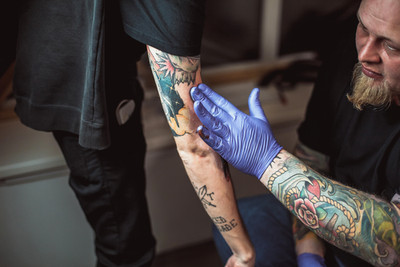UNDERSTANDING THE HEALING STAGES OF TATOO
2019 Apr 17th
Undoubtedly, getting tattoos is an exciting prospect. While everyone seems to be super convinced to keep it forever, the process to a healthy tattoo is not as simple as it appears. It is no more a surprise that a number of people, for myriad reasons, feel tire of their tattoos after sometime and then undergo the painful process of tattoo removal.
While some of them are not happy with the design, there are pretty good chances that their tattoo didn’t healed up the way they expected. For this, it is essential for you to have a quite good knowledge of tattoo healing process, before you get tattooed. To make it simple, here are the details of 3 healing stages you must know.
Stage 1: Heal Open Wound
Being the initial stage of healing, this starts right after the tattoo art gets finished. You need to understand that the new tattoo is very sensitive and body starts working to heal the skin. Consider the area as an open wound and treat it accordingly. Generally, the artist recommends you to keep new tattoo covered for the first twenty-hours. There are chances that the area tends to sting a bit, and it might appear red, raised, or swollen. But there is not much to worry as the inflammation is a natural part of the healing process. Once the scabs start forming over the area, make sure you don’t attempt to remove them. All you have to do is gently wash the area once or twice a day. Use a very mild soap for this and pat dry with a fresh paper towel. Later, you can dab on a light amount of the moisturizing aftercare lotion gently. Different people tend to heal at different rates. However, the first healing stage of a tattoo lasts somewhere between three to seven days. Just ensure that infection doesn't set in.
Stage 2: Heal Itchy Skin
Coming to the second stage of healing, this will be all about combating with the onset of itching. As after the stage 1, the scabs are well formed and they might start to flake off. So the skin around your tattoo tends to become dry and itchy. In fact, many people experience some peeling. Now the scabs can be thin and whitish, and this is normal. Even after the application of aftercare lotion, your tattoo may itch a lot. Further, if you scratch the itchy skin, it can cause damage and ultimately spoil the look of your tattoo. To prevent the urge to scratch you can trust a numbing solution. Apply a lidocaine based cream like NumbSkin, as this will desensitize your skin for few hours. You can curb itchiness without affecting the healing process. Using such a product will minimize discomfort and avoid scarring. Along this, make sure your skin doesn’t sweat a lot as this can also irritate your tattoo.
Stage 3: Heal Drying Out Skin
The third and final stage includes healing of drying tattoo area. Now if you've followed the proper aftercare, most of the scabs have fallen away by this point. However, the area might be dry and mildly tender. In many cases, the ink may no longer appear as vibrant as it did in the beginning. It is now in real shape. Here you need to treat the layer of dead skin which has accumulated over the tattoo and obscures it a bit. For this, you have to clean and moisturize the area daily. Also protect it from prolonged exposure to sun.
Though the healing depends on size, location and complexity of the tattoo, yet the stages will remain common. Be careful to have a gorgeous tattoo at done!








